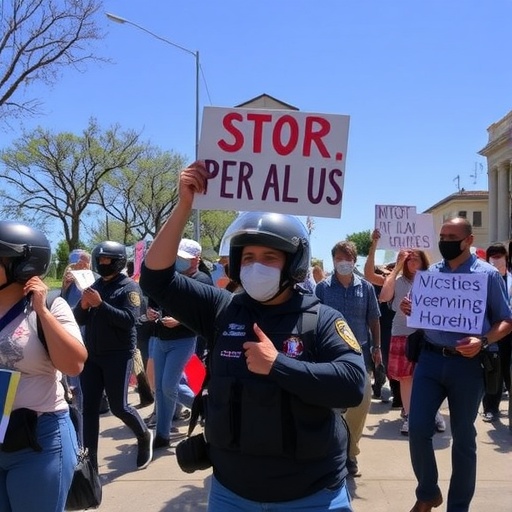Escalating Protests Grip U.S. Cities as Anger Over ICE Operations and Immigration Policies Intensifies
In a wave of unrest sweeping across the United States, thousands of demonstrators took to the streets this week, chanting slogans against ICE operations and demanding sweeping changes to the nation’s immigration framework. The protests, which began in response to a series of high-profile raids in border states, have now spread to major urban centers like New York, Los Angeles, and Chicago, highlighting deep-seated frustrations with federal enforcement tactics. Organizers report over 50,000 participants nationwide, marking one of the largest mobilizations against immigration policies in recent years.
- Demonstrators Clash with Law Enforcement in Key Battlegrounds
- Human Rights Advocates Decry ICE’s Tactics as ‘Systematic Intimidation’
- Political Heavyweights Enter the Fray, Demanding Immigration Overhaul
- Roots of Resistance: Tracing the Surge in Anti-ICE Mobilizations
- Pathways Forward: Will Protests Force a Reckoning on Immigration Enforcement?
The spark for these protests was a controversial ICE sweep in Texas last month, where agents detained more than 200 individuals, including families and long-term residents, in what critics called a “brutal display of overreach.” Eyewitness accounts describe chaotic scenes, with children separated from parents and communities left in fear. “This isn’t enforcement; it’s terror,” said Maria Gonzalez, a protest leader in Los Angeles, whose organization, Families United, has been at the forefront of the movement. As the demonstrations gain momentum, they underscore a growing national divide over how America handles immigration, with polls showing 62% of Americans now viewing ICE’s methods as overly aggressive, according to a recent Pew Research Center survey.
Demonstrators Clash with Law Enforcement in Key Battlegrounds
The heart of the protests has pulsed in cities with large immigrant populations, where demonstrators have blocked major intersections and staged sit-ins outside federal buildings. In Los Angeles, a crowd of over 5,000 gathered at City Hall on Tuesday, waving signs reading “Abolish ICE” and “Immigrants Are Welcome Here.” The event turned tense when police in riot gear advanced, leading to the arrest of 147 people, including several prominent activists. Videos circulating on social media show protesters linking arms and singing hymns, a poignant contrast to the tear gas clouds that followed.
Similar scenes unfolded in New York City, where protests outside the Jacob K. Javits Federal Building drew comparisons to the 2017 Women’s March. Organizers from the New York Immigration Coalition reported that participants included not just immigrants but also students, labor unions, and faith leaders. “We’re seeing a coalition that’s broader than ever,” noted coalition director Murad Awawdeh. Statistics from the Department of Homeland Security indicate that ICE conducted 1,200 arrests in the New York area alone last quarter, fueling the outrage. One detainee, a 19-year-old DACA recipient named Sofia Ramirez, was released after a court intervention but spoke tearfully at the rally: “I came here as a child seeking safety. Now, ICE treats us like criminals.”
Further south, in Houston, protests have targeted oil refineries employing migrant workers, with demonstrators accusing ICE of selective enforcement that spares corporate interests. A report by the American Civil Liberties Union (ACLU) revealed that 70% of ICE detentions in Texas involved individuals without criminal records, a statistic that protesters have plastered across billboards and online campaigns. These clashes have not been without violence; three officers were injured in a skirmish in Dallas, prompting local officials to impose curfews in protest zones.
Human Rights Advocates Decry ICE’s Tactics as ‘Systematic Intimidation’
At the core of the protests lies a fierce critique of ICE’s operational strategies, which human rights groups label as “systematic intimidation.” Amnesty International released a damning report this week, documenting over 300 cases of alleged excessive force during ICE raids since January, including the use of pepper spray on non-violent bystanders. The report quotes survivors like Juan Morales, a farmworker from California: “They came at dawn, guns drawn, like we were terrorists. My wife had a panic attack; she has asthma.” Such testimonies have amplified calls for oversight, with advocates pushing for body cameras on all ICE agents—a measure currently under debate in Congress.
Immigration experts point to a pattern of policy-driven aggression. Under the current administration, ICE’s budget has swelled to $8.5 billion annually, enabling expanded detention centers that now hold over 50,000 people daily, per U.S. Customs and Border Protection data. Critics argue this funding prioritizes deportations over humanitarian aid, exacerbating family separations—a issue that peaked at 5,000 cases in 2018, according to government records. “ICE’s tactics aren’t just inefficient; they’re inhumane,” stated Dr. Elena Vasquez, a professor of migration studies at UCLA, in an interview with Reuters. Her research shows that protests like these have historically led to policy shifts, citing the 1986 Immigration Reform and Control Act as a precedent born from public outcry.
Faith-based organizations have also joined the fray, with Catholic Charities USA organizing prayer vigils that draw parallels to biblical calls for welcoming the stranger. In Chicago, Archbishop Blasé Cupich addressed a crowd of 2,000, saying, “These protests are a moral imperative against the dehumanization of our immigrant brothers and sisters.” The involvement of religious leaders has broadened the movement’s appeal, with petitions garnering over 1 million signatures on Change.org demanding an end to ICE’s “zero-tolerance” approach.
Political Heavyweights Enter the Fray, Demanding Immigration Overhaul
The protests have thrust immigration into the political spotlight, with lawmakers from both parties weighing in amid midterm election pressures. Democratic Senator Alexandria Ocasio-Cortez visited a protest site in Queens, New York, where she vowed to introduce legislation capping ICE’s enforcement powers. “The American people are rising up because our government has failed them,” she declared, echoing sentiments from a bipartisan group of 45 House members who co-sponsored a bill for comprehensive immigration reform last session. On the Republican side, figures like Senator Lindsey Graham have called for “balanced enforcement,” acknowledging that public backlash could sway voter turnout.
Polls from Gallup indicate that 55% of voters now support pathways to citizenship for undocumented immigrants, a shift attributed to the visibility of these protests. In Washington, D.C., a massive rally on the National Mall featured speeches from former ICE officials turned whistleblowers, who revealed internal memos prioritizing arrest quotas over public safety. One such memo, leaked to The Washington Post, instructed agents to target “sanctuary cities” aggressively, leading to a 40% uptick in detentions there. President Biden’s administration faces mounting pressure; White House spokesperson Jen Psaki stated, “We hear the concerns and are committed to humane immigration policies,” though specifics remain elusive.
Local governments are responding too. California’s Governor Gavin Newsom signed an executive order limiting state cooperation with ICE, a move celebrated by protesters but criticized by federal officials as obstructionist. In contrast, Texas Governor Greg Abbott has deployed state troopers to support ICE, escalating tensions. These political maneuvers highlight how protests are reshaping the immigration debate, with advocacy groups like the National Immigration Law Center tracking over 200 bills introduced in state legislatures this year alone, many inspired by grassroots actions.
Roots of Resistance: Tracing the Surge in Anti-ICE Mobilizations
To understand the current protests, one must revisit the turbulent history of U.S. immigration enforcement. ICE, established in 2003 post-9/11, has long been a lightning rod for controversy. The agency’s role expanded dramatically during the Trump era, with deportation numbers reaching 400,000 annually by 2019, per DHS statistics. This period saw the birth of movements like #AbolishICE, which trended on Twitter during family separation scandals and has now evolved into the organized protests of today.
Earlier waves of resistance, such as the 2006 “Day Without Immigrants” marches that drew 1 million participants, set the stage for today’s activism. Historians like Mae Ngai from Columbia University note that immigration protests often surge during economic downturns or policy pivots. The COVID-19 pandemic, which disproportionately affected migrant workers, added fuel; a 2021 study by the Migration Policy Institute found that Latino communities, hit hardest by the virus, reported a 30% increase in anti-ICE sentiment. Social media has supercharged this, with hashtags like #StopICE garnering 10 million views on TikTok in the past month.
Demographic shifts play a role too. With the U.S. Latino population projected to reach 111 million by 2060, according to the Census Bureau, younger generations are leading the charge. Student-led groups at universities like UC Berkeley have organized campus walkouts, integrating immigration justice into broader social justice curricula. Veteran activists mentor newcomers, sharing tactics from past struggles, ensuring the movement’s resilience despite counter-narratives from border security hawks.
Economically, protests highlight immigrants’ contributions: undocumented workers pay $13 billion in taxes yearly, per the Institute on Taxation and Economic Policy, yet face deportation fears that stifle community stability. Stories of mixed-status families, like that of Detroit mechanic Carlos Herrera, whose deportation would orphan his U.S.-born children, personalize the stakes and drive participation.
Pathways Forward: Will Protests Force a Reckoning on Immigration Enforcement?
As protests show no signs of abating, the question looms: what changes might emerge from this groundswell? Advocacy groups predict that sustained pressure could lead to congressional hearings on ICE reform by year’s end, potentially including bans on raids in sensitive areas like schools and hospitals. The Biden administration has already paused some deportations, a tentative step that protesters view as insufficient without broader immigration amnesty.
Looking ahead, international eyes are on the U.S., with the United Nations Human Rights Council urging investigations into ICE practices. Domestically, ballot initiatives in states like Arizona and Nevada could enshrine protections for immigrants, influenced by protest momentum. Experts forecast that if protests maintain their scale— with planned national days of action in October—they might catalyze a new era of policy, reminiscent of the Dream Act’s near-passage in 2010.
Yet challenges persist: funding for counter-protest measures and legal battles could prolong the standoff. As one organizer put it, “This is just the beginning. The soul of America is on trial.” With ICE operations under scrutiny and immigration debates heating up, the coming months promise pivotal developments that could redefine enforcement for generations.









